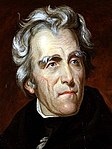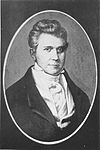1822–23 United States Senate elections
| ||||||||||||||||||||||||||||
16 of the 48 seats in theUnited States Senate(plus special elections) 25 seats needed for a majority | ||||||||||||||||||||||||||||
|---|---|---|---|---|---|---|---|---|---|---|---|---|---|---|---|---|---|---|---|---|---|---|---|---|---|---|---|---|
| ||||||||||||||||||||||||||||
 Results: Federalist holdDem-Republican hold Legislature Failed To Elect | ||||||||||||||||||||||||||||
| ||||||||||||||||||||||||||||
The1822–23 United States Senate electionswere held on various dates in various states. As theseU.S. Senateelections were prior to the ratification of theSeventeenth Amendmentin 1913, senators were chosen bystate legislatures.Senators were elected over a wide range of time throughout 1822 and 1823, and a seat may have been filled months late or remained vacant due tolegislative deadlock.[1]In these elections, terms were up for the senators inClass 2.
TheDemocratic-Republican Partycontinued to maintain almost complete control of the Senate.
Factions[edit]
At the very end of the next Congress, the1824 United States presidential electionled to a contingency election, decided by the Congress. In that election, Senators split into factions in support ofWilliam H. Crawford,Andrew Jackson,orJohn Quincy AdamsandHenry Clay.Even though that election wasn't held until more than two years after the Senate elections in this article, those factions are noted below as "Crawford," "Jackson," or "Adams-Clay."
Results summary[edit]
Senate party division,18th Congress(1823–1825)
- Majority party: Democratic-Republican (42–43)
- Minority parties: National Republican & Federalist (4–5)
- Total seats: 48
Change in composition[edit]
Before the elections[edit]
Composition after the January 24, 1822Delaware special election.
| DR1 Del. Gain |
DR2 | DR3 | DR4 | ||||||
| DR14 | DR13 | DR12 | DR11 | DR10 | DR9 | DR8 | DR7 | DR6 | DR5 |
| DR15 | DR16 | DR17 | DR18 | DR19 | DR20 | DR21 | DR22 | DR23 | DR24 |
| Majority → | DR25 | ||||||||
| DR34 Ky. Ran |
DR33 Ill. Ran |
DR32 Ga. Ran |
DR31 Ala. Ran |
DR30 | DR29 | DR28 | DR27 | DR26 | |
| DR35 La. Ran |
DR36 Me. Ran |
DR37 Miss. Ran |
DR38 N.J. Ran |
DR39 N.C. Ran |
DR40 R.I. Ran |
DR41 S.C. Ran |
DR42 Tenn. Ran |
DR43 Va. Ran |
DR44 N.H. Retired |
| F1 | F2 | F3 Mass. Ran |
F4 Del. | ||||||
Result of the regular elections[edit]
| DR1 | DR2 | DR3 | DR4 | ||||||
| DR14 | DR13 | DR12 | DR11 | DR10 | DR9 | DR8 | DR7 | DR6 | DR5 |
| DR15 | DR16 | DR17 | DR18 | DR19 | DR20 | DR21 | DR22 | DR23 | DR24 |
| Majority → | DR25 | ||||||||
| DR34 Ky. Re-elected |
DR33 Ill. Re-elected |
DR32 Ga. Re-elected |
DR31 Ala. Re-elected |
DR30 | DR29 | DR28 | DR27 | DR26 | |
| DR35 La. Re-elected |
DR36 Me. Re-elected |
DR37 Miss. Re-elected |
DR38 N.J. Re-elected |
DR39 R.I. Re-elected |
DR40 Va. Re-elected |
DR41 N.H. Hold |
DR42 N.C. Hold |
DR43 S.C. Hold |
DR44 Tenn. Hold |
| F1 | F2 | F3 Mass. Re-elected |
V1 Del. F Loss | ||||||
| Key: |
|
|---|
Race summaries[edit]
Boldstates link to specific election articles.
Special elections during the preceding Congress[edit]
In these special elections, the winners were seated during 1822 or before March 4, 1823; ordered by election date.
| State | Incumbent | Results | Candidates | ||
|---|---|---|---|---|---|
| Senator | Party | Electoral history | |||
| Delaware (Class 1) |
Vacant | Outerbridge Horsey(F) had resigned March 3, 1821. New senator electedJanuary 24, 1822. Democratic-Republican gain. |
| ||
| Ohio (Class 3) |
William A. Trimble | Democratic-Republican | 1819 | Incumbent died December 13, 1821. New senator electedJanuary 29, 1822. Democratic-Republican hold. |
|
| Massachusetts (Class 2) |
Harrison Gray Otis | Federalist | 1816 | Incumbent resigned May 30, 1822, to run forMayor of Boston. New senator electedJune 5, 1822. Successor was also elected to the next term, see below. Federalist hold. |
|
| Alabama (Class 3) |
John W. Walker | Democratic-Republican | 1819 | Incumbent resigned December 12, 1822, due to failing health. New senator electedDecember 12, 1822. Democratic-Republican hold. |
|
| Maryland (Class 1) |
William Pinkney | Democratic-Republican | 1819(special) 1821 |
Incumbent died February 25, 1822. New senator electedDecember 17, 1822. Democratic-Republican hold. |
|
| Virginia (Class 2) |
James Pleasants | Democratic-Republican | 1819(special) | Incumbent resigned December 15, 1822, to becomeGovernor of Virginia. New senator electedDecember 18, 1822. Successor was later re-elected to the next term, see below. Democratic-Republican hold. |
|
Races leading to the next Congress[edit]
In these regular elections, the winner was seated on March 4, 1823; ordered by state.
All of the elections involved the Class 2 seats.
| State | Incumbent | Results | Candidates | ||
|---|---|---|---|---|---|
| Senator | Party | Electoral history | |||
| Alabama | William R. King | Democratic-Republican | 1819 | Incumbent re-elected December 12, 1822. |
|
| Delaware | Nicholas Van Dyke | Federalist | 1817 | Legislature failed to elect. Federalist loss. Incumbent would later bere-elected late in 1824. |
[data missing] |
| Georgia | Nicholas Ware | Democratic-Republican | 1821(special) | Incumbent re-elected in 1822 or 1823. |
|
| Illinois | Jesse B. Thomas | Democratic-Republican | 1818 | Incumbent re-elected in 1823. |
|
| Kentucky | Richard Mentor Johnson | Democratic-Republican | 1819(special) | Incumbent re-elected in 1823. |
|
| Louisiana | Henry Johnson | Democratic-Republican | 1818(special) | Incumbent re-elected in 1823. |
|
| Maine | John Chandler | Democratic-Republican | 1820 | Incumbent re-elected in 1823. |
|
| Massachusetts | James Lloyd | Federalist | 1808(special) 1808 1813(Resigned) 1822(special) |
Incumbent re-elected as an Adams-Clay Federalist in 1822. Winner was also elected to finish the current term, see above. |
|
| Mississippi | Thomas Hill Williams | Democratic-Republican | 1817 | Incumbent re-elected in 1823. |
|
| New Hampshire | David L. Morril | Democratic-Republican | 1816 | Incumbent retired. New senator elected in 1823. Democratic-Republican hold. |
|
| New Jersey | Mahlon Dickerson | Democratic-Republican | 1817 | Incumbent re-elected in 1823. |
|
| North Carolina | Montfort Stokes | Democratic-Republican | 1816(special) 1816 |
Incumbent lost re-election. New senator elected in 1822. Democratic-Republican hold. |
|
| Rhode Island | Nehemiah R. Knight | Democratic-Republican | 1821(special) | Incumbent re-elected in 1823. |
|
| South Carolina | William Smith | Democratic-Republican | 1810(special) 1816 |
Incumbent lost re-election. New senator elected in 1822. Democratic-Republican hold. |
|
| Tennessee | John Williams | Democratic-Republican | 1815(special) | Incumbent lost re-election. New senator elected October 28, 1823.[5] Democratic-Republican hold. |
|
| Virginia | John Taylor of Caroline | Democratic-Republican | 1822(special) | Incumbent re-elected in 1823. Winner was also elected to finish the current term, see above. |
|
Special elections during the next Congress[edit]
In these special elections, the winners were elected in 1823 after March 4; ordered by election date.
| State | Incumbent | Results | Candidates | ||
|---|---|---|---|---|---|
| Senator | Party | Electoral history | |||
| New Jersey (Class 1) |
Samuel L. Southard | Democratic-Republican | 1821(Appointed) 1820 |
Incumbent resigned March 4, 1823, to becomeU.S. Secretary of the Navy. New senator electedNovember 12, 1823. Democratic Republican hold. |
|
Alabama[edit]
Alabama (regular)[edit]
IncumbentWilliam R. Kingwas first elected in1819.He was reelected with the votes of over 41% of the legislators, defeating William Crawford, former agent to the Choctaw nationJohn McKee,and another candidate named William King.
| |||||||||||||||||||||||||||||
| |||||||||||||||||||||||||||||
This sectionneeds expansion.You can help byadding to it.(December 2019) |
Alabama (special)[edit]
IncumbentJohn Williams Walkerresigned on December 12, 1822, due to failing health. He would die in April of the following year.William Kellywas elected in his place with 56.65% of the votes of state legislators, defeatingstate representativeJohn McKinley.
| |||||||||||||
| |||||||||||||
This sectionneeds expansion.You can help byadding to it.(December 2019) |
Delaware[edit]
Delaware (regular)[edit]
TheDelaware General Assemblydid not elect a candidate to the United States Senate.
This sectionneeds expansion.You can help byadding to it.(December 2019) |
Delaware (special)[edit]
Federalist incumbentOuterbridge Horseyretired in the1820/1821 Senate elections.TheDelaware General Assemblyfailed to elect a successor.Caesar Augustus Rodney,theU.S. representativeforDelaware's at-large congressional districtand a nephew offounding fatherCaesar Rodney,was elected late.
This sectionneeds expansion.You can help byadding to it.(December 2019) |
Georgia[edit]
Incumbent Democratic-RepublicanNicholas Warewas reelected in 1823.
This sectionneeds expansion.You can help byadding to it.(December 2019) |
Illinois[edit]
Incumbent Democratic-RepublicanJesse B. Thomaswas reelected in 1823.
This sectionneeds expansion.You can help byadding to it.(December 2019) |
Kentucky[edit]

Incumbent Democratic-RepublicanRichard Mentor Johnsonwas reelected in 1823.
This sectionneeds expansion.You can help byadding to it.(December 2019) |
Louisiana[edit]
Incumbent Democratic-Republican Henry S. Johnson was reelected in 1823
This sectionneeds expansion.You can help byadding to it.(December 2019) |
Maine[edit]
Incumbent Democratic-RepublicanJohn Chandlerwas reelected in 1823.
This sectionneeds expansion.You can help byadding to it.(December 2019) |
Maryland (special)[edit]
This sectionneeds expansion.You can help byadding to it.(November 2022) |
| ||||||||||||||||
80 members of theMaryland General Assembly | ||||||||||||||||
|---|---|---|---|---|---|---|---|---|---|---|---|---|---|---|---|---|
| ||||||||||||||||
IncumbentDemocratic-RepublicanWilliam Pinkneydied on February 25, 1822.CongressmanSamuel Smith,a Democratic-Republican, was elected to the seat on December 17, 1822.[6]
Massachusetts[edit]
Massachusetts (regular)[edit]
Incumbent FederalistJames Lloydwas reelected in 1822 after being first elected in a special election (see below).
This sectionneeds expansion.You can help byadding to it.(December 2019) |
Massachusetts (special)[edit]

Incumbent SenatorHarrison Gray Otisresigned on May 30, 1822, to run forMayor of Boston.Former senatorJames Lloyd,a Federalist was elected on June 5, 1822.
This sectionneeds expansion.You can help byadding to it.(December 2019) |
Mississippi[edit]
Incumbent Democratic-RepublicanThomas Hill Williamswas reelected in 1823.
This sectionneeds expansion.You can help byadding to it.(December 2019) |
New Hampshire[edit]
Incumbent Democratic-RepublicanDavid L. Morrilretired.Governor of New HampshireSamuel Bellwas elected as a Democratic-Republican.
This sectionneeds expansion.You can help byadding to it.(December 2019) |
New Jersey[edit]
New Jersey (regular)[edit]
Incumbent Democratic-RepublicanMahlon Dickersonwas reelected in 1823.
This sectionneeds expansion.You can help byadding to it.(December 2019) |
New Jersey (special)[edit]
Incumbent Democratic-Republican Samuel L. Southard resigned on March 3, 1823, to become the U.S. Secretary of the Navy. Democratic-Republican Joseph McIlvaine was elected to finish his term on November 12, 1823.
This sectionneeds expansion.You can help byadding to it.(December 2019) |
North Carolina[edit]
Incumbent Democratic-RepublicanMontfort Stokeswas defeated for reelection byJohn Branch,a fellow Democratic-Republican, in 1822.
This sectionneeds expansion.You can help byadding to it.(December 2019) |
Ohio (special)[edit]
IncumbentJeffersonian RepublicanWilliam A. Trimbledied on December 13, 1821, at the age of 35.Governor of Ohio,Ethan Allen Brown,was elected to finish Trimble's term.
This sectionneeds expansion.You can help byadding to it.(December 2019) |
Rhode Island[edit]
Incumbent Democratic-RepublicanNehemiah R. Knightwas reelected in 1823.
This sectionneeds expansion.You can help byadding to it.(December 2019) |
South Carolina[edit]
Incumbent Democratic-RepublicanWilliam Smithlost reelection to Democratic-RepublicanRobert Y. Hayne.
This sectionneeds expansion.You can help byadding to it.(December 2019) |
Tennessee[edit]
Former senator and generalAndrew Jacksondefeated incumbentJohn Williamsin the election for Senate. Jackson was put up as the Jacksonian candidate after Williams decided to support William H. Crawford in the1824 Presidential Election.[7]Williams was endorsed byDavy Crockett.[8]Jackson's return to the senate after nearly 25 years out of office marks the second longest gap in service in U.S. Senate history. Jackson would resign two years later in 1825, and eventually be electedpresidentin1828.
| |||||||||||||||||||
60 legislators 31 votes needed to win | |||||||||||||||||||
|---|---|---|---|---|---|---|---|---|---|---|---|---|---|---|---|---|---|---|---|
| |||||||||||||||||||
This sectionneeds expansion.You can help byadding to it.(December 2019) |
Virginia[edit]
Virginia (regular)[edit]
After being elected in the special election (see below), incumbentJohn Taylorwas reelected in 1823.
This sectionneeds expansion.You can help byadding to it.(December 2019) |
Virginia (special)[edit]
IncumbentJames Pleasantsresigned on December 15, 1822, to becomeGovernor of Virginia.Former senatorJohn Taylor,a Democratic-Republican, was elected with 51.8% of the votes of legislators over former congressmenHenry St. George TuckerandJohn Tyler,both Democratic-Republicans.
| |||||||||||||||||
| |||||||||||||||||
This sectionneeds expansion.You can help byadding to it.(December 2019) |
See also[edit]
References[edit]
- ^"17th Amendment to the U.S. Constitution: Direct Election of U.S. Senators (1913)".National Archives and Records Administration.February 8, 2022.
- ^"Our Campaigns - AL US Senate Race - Dec 12, 1822".www.ourcampaigns.com.RetrievedOctober 31,2019.,citing1822 House Journal, Dec 12.
- ^"Virginia 1822 U.S. Senate, Special".Tufts Digital Collations and Archives.A New Nation Votes: American Election Returns 1787–1825.Tufts University.RetrievedJune 4,2019.
- ^"Our Campaigns - AL Senate Race - Dec 12, 1822".
- ^"Tennessee 1823 U.S. Senate".Tufts Digital Collations and Archives.A New Nation Votes: American Election Returns 1787–1825.Tufts University.RetrievedJune 4,2019.
- ^"Our Campaigns - MD US Senate Race -Dec 11, 1822".www.ourcampaigns.com.Retrieved2022-11-05.
- ^Higgins, Ruth L.; Driver, Leota S. (December 1933)."Fanny Kemble".The Mississippi Valley Historical Review.20(3): 416.doi:10.2307/1886861.ISSN0161-391X.JSTOR1886861.
- ^"<sc>John R. Finger</sc>.Tennessee Frontiers: Three Regions in Transition.(A History of the Trans-Appalachian Frontier.) Bloomington: Indiana University Press. 2001. Pp. xxiii, 382. $39.95 ".The American Historical Review.February 2003.doi:10.1086/ahr/108.1.185-a.ISSN1937-5239.
- Party Division in the Senate, 1789-Present,via Senate.gov









